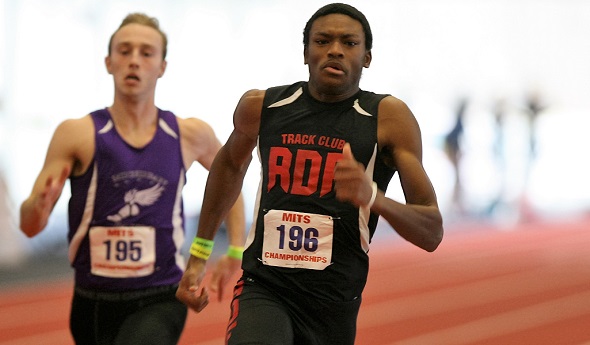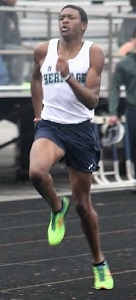
Heritage Sprinter Off to Stunning Start
By
Paul Costanzo
Special for MHSAA.com
May 2, 2018
When Marcus Montgomery took the advice of his good friend Juwan Roberts and joined the Saginaw Heritage track team prior to the 2017 season, he did it with the simple expectation of having fun.
 He never imagined where he would be a year later – among the top 400-meter runners in the state and starting to see interest from Division I colleges. Montgomery’s personal best 400 time of 48.81 seconds, in a race he didn’t run competitively until this past winter, ranks third in the state this season in all divisions.
He never imagined where he would be a year later – among the top 400-meter runners in the state and starting to see interest from Division I colleges. Montgomery’s personal best 400 time of 48.81 seconds, in a race he didn’t run competitively until this past winter, ranks third in the state this season in all divisions.
It’s an emergence longtime Heritage boys track coach Gary Loubert called “nothing short of stunning.”
“I wouldn’t have believed (this was possible),” the Heritage senior said. “Last year, at the beginning of the season, (Heritage girls track coach Ricky Flowers) did say that he was going to get me to states, but that was for the 100. But now, he’s got me somewhere I never thought I would be in a whole different event.”
As a junior, Montgomery started as a jumper, and eventually moved to sprints, where he was solid in the 100 and 200. While his times didn’t scream championship runner, the raw ability he showed while running at least gave a hint it could be pulled out of him. At 6-foot-4, Montgomery had the stride length – he just needed to learn how to use it.
Enter Flowers, a former World Class sprinter who ran at Michigan State University. Flowers, who coaches sprinters for both Heritage teams, took Montgomery under his wing, and even through the disappointment of him being academically ineligible to run in the 2017 Regional meet, he stuck with the talented youngster, encouraging him to work on the sport in the offseason.
“I just saw the length that he had and how he ran, and I said, ‘This kid probably could do something with some teaching,’” Flowers said. “I started giving him workouts and teaching him just how to run. This fall, I put it out to some of the kids to join my track club … long story short, Marcus ran indoors, he ran a 48. He came to all my practices, he got a taste of winning and learning how to run and finish races. Now we can’t keep him off the track. The best is yet to come.”
Montgomery’s first 400-meter run was more of a learning experience than a triumph. He finished it in about 54 seconds after running with no plan in place.
“For my first time, I did not have a strategy at all,” he said. “I full-on sprinted. I’m not going to lie, I was winded halfway through it. I honestly didn’t think (it would be my race) because of how winded I was, but just kept working at it.”
He ran at the Michigan Indoor Track Series meet in Saginaw and placed fourth with a time of 49.39 seconds, and won the Saginaw Valley State University Division 1 Indoor Invitational with a time of 49.2. He also qualified for the national competition in New York, but did not make the trip.
 Now, even though the weather has been less than ideal for displays of speed, he’s carried that momentum over into his outdoor season, where he’s yet to be defeated in the 400. His success on the track has led to more focus off it, as Montgomery has put more focus on his school work.
Now, even though the weather has been less than ideal for displays of speed, he’s carried that momentum over into his outdoor season, where he’s yet to be defeated in the 400. His success on the track has led to more focus off it, as Montgomery has put more focus on his school work.
“The success Marcus has been enjoying is transformative on so many other levels,” Loubert said. “He has grown in wonderful ways with a confident, but courteous attitude. He is extremely outgoing and a pure joy to coach. His teammates have really enjoyed watching the growth, too. He has definitely become a lead-by-example athlete. They are inspired by his progress and admire how smooth he runs. A little hard work and a growing positive attitude have been a catalyst for not only Marcus, but others are noticing and buying in. He is writing a story that will help strengthen our culture as a program.”
The prospect of running collegiately is a major motivator for Montgomery, who realizes that listening to his friend and coming out for track a year ago could very well have changed his life. He said the possibility has made him want to become a better student, as well as a better athlete.
But on the track, the future isn’t his concern.
“Coach has talked to me about that, about the things I can do and the things I have possibly in the future,” Montgomery said. “Myself, I’m more concentrated on right now. I’m sure when that time comes, it will hit me and my mind will be blown.”
Montgomery is worrying about being the best 400-meter runner he can be. Being the best 400-meter runner in Heritage history (the school record is within sight at 48.1), and the best 400-meter runner in the state.
“I want to be one of those guys that brings back a state championship for Heritage,” he said. “Most of this I’m doing not only for myself, but for my family and my school in general. I want to make everyone proud.”
 Paul Costanzo served as a sportswriter at The Port Huron Times Herald from 2006-15, including three years as lead sportswriter, and prior to that as sports editor at the Hillsdale Daily News from 2005-06. He can be reached at [email protected] with story ideas for Genesee, Lapeer, St. Clair, Sanilac, Huron, Tuscola, Saginaw, Bay, Arenac, Midland and Gladwin counties.
Paul Costanzo served as a sportswriter at The Port Huron Times Herald from 2006-15, including three years as lead sportswriter, and prior to that as sports editor at the Hillsdale Daily News from 2005-06. He can be reached at [email protected] with story ideas for Genesee, Lapeer, St. Clair, Sanilac, Huron, Tuscola, Saginaw, Bay, Arenac, Midland and Gladwin counties.
PHOTOS: (Top) Marcus Montgomery (196) charges through a turn during the 400 at the MITS state meet in February at Saginaw Valley State University. (Middle) Montgomery sprints the final stretch during a race this spring. (Top photo by RunMichigan.com; bottom photo courtesy of Marcus Montgomery.)

Hastings Relays Reigns as State's Oldest Continuous Track & Field Meet
By
Steve Vedder
Special for MHSAA.com
April 10, 2024
Bob Branch remembers dabbling in other sports, but his first love was always running.
 The Hastings High School graduate admits he could never hit a baseball, football didn't especially appeal to him and basketball was just another way to spend time with friends. But for Branch, now 93, there was always track. That's the sport where his fondest and sharpest memories remain. And if you're talking track, many of his favorite memories come from participation in the state's oldest continuous track meet, the Hastings Relays.
The Hastings High School graduate admits he could never hit a baseball, football didn't especially appeal to him and basketball was just another way to spend time with friends. But for Branch, now 93, there was always track. That's the sport where his fondest and sharpest memories remain. And if you're talking track, many of his favorite memories come from participation in the state's oldest continuous track meet, the Hastings Relays.
Always held in early April, the meet dates back to 1937 – a bygone time that saw the first hostilities of World War II, gas at 20 cents a gallon and a loaf of bread selling for a dime.
And at a dusty old track surrounding the county fairgrounds in Hastings, a small relay event that included a scattering of participants from a dozen high schools was taking its first tentative steps.
Branch recalls a time when kids would run home after track practice because there were no buses, inexperienced young coaches had little actual knowledge of running fundamentals, and athletes looked at the sport as an afterthought after spending most of their high school days playing football and basketball.
 For Branch, the relays were the ideal way to ease into the track season.
For Branch, the relays were the ideal way to ease into the track season.
"I just liked to run," said Branch. "I remember I anchored a relay with my brother, and it always seemed cold when we had that meet. I remember teams would come from all over and you saw a lot of good athletes. Everybody seemed to have someone who was really good. Track wasn't very popular at that time, but I have a lot of good memories from running."
The Hastings Relays, which has changed formats and even names during its nearly nine-decade history, would traditionally kick off the track season. The meet was originally held at a makeshift quarter-mile track which surrounded the town's fairgrounds and was part of the city's annual Hastings Carnival – the track would become the midway during fair time.
The meet eventually moved to Johnson Field when the football field was dedicated in 1949 and ballooned to as many as 50 teams at its peak in 1957. For more than seven decades it was known as the Hastings Relays and then the Hastings Co-Ed relays before becoming the current Hastings Invitational, with the latest edition scheduled for Friday.
Johnson Field had a cinder track before it became an all-weather surface in the 1980s. During a time long before computers would be used to organize meet heats in mere minutes, Hastings coaches of all sports – defined as "volunteers" by the athletic department – would meet on the Friday before competition to hash out events.
People associated with the meet still recall the camaraderie built on those long Friday nights, followed by working what would often become 10-hour meets. Steve Hoke has been involved since watching his father, Jack, who coached teams at 15 of the meets beginning in 1951 and also had run in the first Hastings Relays. Steve Hoke later competed in the Relays as well during the early 1970s before becoming an assistant track coach, later the Hastings athletic director and now a volunteer worker.
"It was always a huge deal," said Hoke, who said the meet began as a pure relay event before transitioning to its current team format in the 1990s. "I remember we'd line the track the night before, and all the coaches would come to the house to organize everything. There was a brotherhood.”
 If you quiz many of the fleet of volunteers who've worked the relays over the years, each has a different memory from the meet. While Hoke describes the brotherhood and Branch the outstanding competition, others remember weather and the time a thunderstorm wiped out the line markings on the cinder track, or waking up to find three inches of snow that caused a rare cancellation of the meet. Others recall the shock of moving from the cinder to all-weather track or using the meet as an early measuring stick of what it would take to qualify for the state meet. The real old-timers remember the meet disappearing for three years during World War II.
If you quiz many of the fleet of volunteers who've worked the relays over the years, each has a different memory from the meet. While Hoke describes the brotherhood and Branch the outstanding competition, others remember weather and the time a thunderstorm wiped out the line markings on the cinder track, or waking up to find three inches of snow that caused a rare cancellation of the meet. Others recall the shock of moving from the cinder to all-weather track or using the meet as an early measuring stick of what it would take to qualify for the state meet. The real old-timers remember the meet disappearing for three years during World War II.
Hastings native and Western Michigan grad Tom Duits was the state’s second collegian to break the four-minute mile when he ran a 3:59.2 at a meet in Philadelphia in 1978. Duits, who ran in three Hastings Relays, was in line to join the U.S. Olympic team in 1980 before the United States pulled out of the games due to tension with Russia.
Duits has his own memories of the meet and the competition he faced there.
"I remember sunshine and being excited to be competing again. There were all these athletes swarming around; it was an awesome display of talent," he said. "It was always one of the best meets we'd be in. You could pretty much see the level of runners who would be at state, which made it a big deal. It was always early, but you could tell where you stood. It was great exposure."
Hastings track star Wayne Oom competed in four Hastings Relays from 1984-87. One of his sharpest memories was the difference between running on a raw cinder track versus the far more comfortable all-weather surface.
"Those cinders would grind into your skin," said Oom, part of the Hastings school record in the two-mile relay. "But I think it helped us because when we'd go to other tracks, it seemed we would run faster. I remember how competitive it was, especially in the distances. There were some great runners."
While participants have their unique memories, so do coaches. Former Saxons coach Paul Fulmer remembers 2008 when his team finished first on the boys side of the meet while his wife, Grand Haven coach Katie Kowalczyk-Fulmer, saw her girls team win the championship.
 "I knew we were one of the favorites to win because we were usually near the top of our conference and Regional," he said. "But then Katie's team was pretty good, and it was cool for them to win too."
"I knew we were one of the favorites to win because we were usually near the top of our conference and Regional," he said. "But then Katie's team was pretty good, and it was cool for them to win too."
Fulmer, who coached Hastings from 1978-81 and then 1985-2010, said at least part of the meet's popularity was derived from a unique way of scoring. Instead of individuals earning points solo, participants worked in pairs. For instance, two athletes would combine their shot put or long jump scores. New events such as the 1,500 relay and sprint medley were added.
"We had a tradition of being the state's oldest meet, and that was a big deal," Fulmer said. "And we ran a good relay; that attracted teams too. We took a lot of pride in that.
"And we'd get quite a lot of people to come to the meet. We'd set up until like 9 or 10 p.m., and then we'd have a party with all the coaches on Friday night."
While the meet has stretched 87 years, Branch said early participants and current runners have one thing in common: a drive to win. Branch ran in an era when the popularity of high school track was in its infancy. Today some of the best all-around athletes at a school are involved in the track program. The relays span the nearly nine decades in between.
"The quality of teams has gotten better and better," said Branch, the 1947 Lower Peninsula Class B Finals champ in the 220. "And this has made for a better meet. We would get guys who played football or baseball kind of drift into track, and that made the sport better. I think people began to appreciate track because we'd get teams from all over.
"We went from not really knowing what we were doing to track being a good sport. Even then, I'm not sure we appreciated what we had. We really liked the Hastings Relays and always wanted to do well there. It became popular and quite an honor to do well. Those are the kind of things I remember."
PHOTOS (Top) Racers run at the Hastings Relays, with several more awaiting their turns to compete at the longtime meet. (2) The author wrote on the 50th anniversary of the Relays for the Hastings Banner nearly 40 years ago. (3) Past athlete, coach and athletic director Steve Hoke shows some of the Relays awards from the 1930s. (4) Tom Duits was one of the state’s biggest track stars of the 1970s and ran in three Hastings Relays. (Top photo by Dan Goggins, Hoke photo provided by Steve Hoke and Duits photos provided by Tom Duits.)

